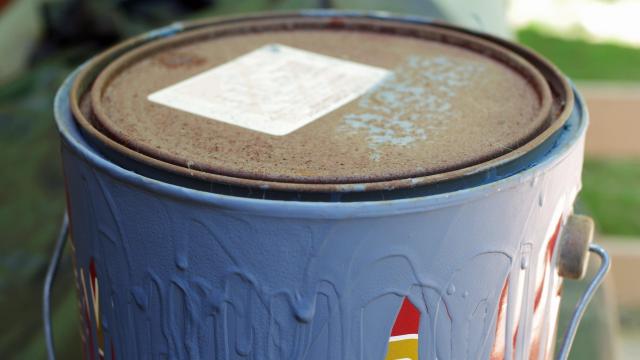The paint that adorns my living room walls is a light yellow hue known as “Lemon Ice.” It works perfectly with my decor and is a huge a step up from the marigold colour that was there when I moved in. In the years since I painted, I’ve kept the leftover paint in my closet to use to touch up tiny scuffs and scrapes and keep my walls looking fresh. But how long can I count on my backup supply lasting?
It’s seems like a can of paint should last forever. Like that can of beans your parents have been hoarding since Y2K, it’s stored in an airtight can with the lid hammered shut. And it’s just a bunch of chemicals; how could it ever go bad? Well, according to the experts, paint does have a shelf life — yet when I open my year old paint and give it a stir, it looks brand new to me. So how can you tell when it’s time to throw out the old paint and pick up a new can? Here are a few signs that tell you when your paint is past its prime.
By the numbers
If, like me, you can’t tell whether the paint is any good by looking at it, it’s a good idea to assume it has passed its use-by date if a certain amount of time has passed. Lucas London, CEO and co-founder of design site Lick, told Real Homes paint should ideally be used up within six months of opening. Any longer and the paint can lose its lustre, and your touch-up attempts will fail to blend in on the wall and you may need to end up repainting a larger area.
Typically the label on a can of paint will list the date it was mixed alongside the formula used to concoct the colour. If more than six months has passed and you’d rather buy a new can than risk having to repaint multiple times, dispose of the paint but save (or take a picture of) the label so you can get another can of the same brand mixed in the same way.
That six month lifespan isn’t a guarantee, either; as Consumer Reports notes, “leftover latex paint can last years, even a decade, or go bad in mere months.” So to find out if it’s good or not, you’ll have to open it up and take a look — or a sniff.
Observe the consistency and smell
When you open your old can, take notice of the smell of the paint (no, I’m not telling you to huff paint). If the paint gives off the familiar chemical odor of… paint, you should be fine. However, according to the home guide site SFGate if you smell a pungent, rancid odor, the paint has gone bad and needs to be tossed.
Consistency matters, too: You might notice a thick, rubbery or oily layer has risen to to the top. Mix the liquid thoroughly with a paint stirrer; if it blends smoothly back together and stays that way after 10 to 15 minutes, it’s likely still good, notes Consumer Reports. If the oil and paint separate again or don’t mix at all, but look more like lumpy curdled milk, there’s no saving that can.
Even unopened paint cans have different shelf lives
What if you bought a can but never had it mixed? Home improvement site HomeStars notes unopened acrylic and water-based acrylic paint can last up to ten years, while oil-based paints can last up to fifteen. “Unopened paint maintains its ratio of liquids and semi-solids, which is why it’s fine to use after a long period of time. Once the can is opened and exposed to air, this ratio begins to change,” they explain.
Where you keep the paint can affect its longevity
Paint should be kept in a cool, dry place and appropriately sealed by hammering in the metal cap back on with a rubber mallet (you don’t want to use a regular hammer, as it can dent the lid, making opening the can again a pain). TO help keep the paint fresh, home improvement retailer TrueValue advises placing plastic wrap over the can’s opening before replacing the lid. Then, store the can upside down to prevent air from getting in. (Probably want to be really confident you’ve closed the can securely before you attempt that, however.)
TrueValue also notes the importance of keeping the paint out of extreme cold or heat. If you left it on the back porch, in a shed, in an unheated garage, or anywhere else it was exposed to the elements, the paint’s chemical makeup may have been altered, rendering it unusable.
Once you find discover your paint is not salvageable, be sure to dispose of it properly. Handy man Bob Vila recommends adding sawdust to the can to dry out the leftover paint and contacting your local waste management to find an environmentally safe way to dispose of the can.

Leave a Reply
You must be logged in to post a comment.